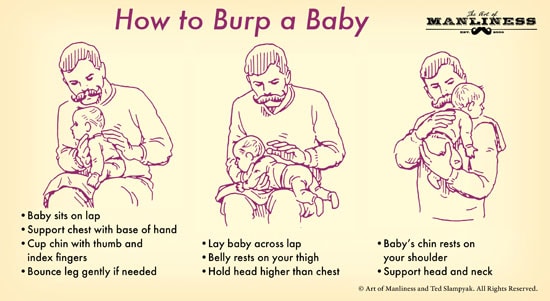Burping a newborn is an important part of feeding. Babies often swallow air when they eat, which can make them uncomfortable. Burping helps release this trapped air and can prevent fussiness. Many new parents wonder how to burp their baby properly. This guide will walk you through the steps you need to know.
Why Burping a Newborn is Important
Burping is crucial for your baby’s comfort. When babies consume milk, either from breastfeeding or a bottle, they can gulp air along with the liquid. This air can lead to gas and discomfort. If not addressed, it may cause your newborn to cry or seem restless. Effective burping can help reduce these issues and make feeding times more enjoyable for both you and your baby.
Would you like to see this content of ours How to Swaddle a Newborn Properly
When Should You Burp Your Newborn?
You should burp your baby during and after feeding sessions. It’s common to pause every few minutes during a feed to help your baby release any air they might have swallowed. After finishing the bottle or breastfeeding, make sure to burp your newborn again. Here are some key times to remember:
- After every 2-3 ounces of formula or breast milk.
- After breastfeeding sessions, especially if the baby has been feeding for a while.
- If your baby seems fussy or uncomfortable during or after a feed.
How to Burp a Newborn: Step by Step
Now, let’s look at how to burp a newborn in detail. Here are the steps you can follow:
Step 1: Choose Your Position
Select a comfortable position for both you and your baby. There are several ways to hold your newborn while burping:
- Over the Shoulder: Hold your baby upright against your shoulder. Make sure their head is supported and their stomach is pressed against you.
- Sitting on Your Lap: Sit your baby on your lap facing away from you. Support their chin and chest with one hand while gently patting their back with the other.
- Laying Across Your Lap: Lay your baby on their stomach across your lap. Use one hand to support their head and the other hand to pat their back.
Step 2: Support Your Baby’s Head and Neck
Newborns need support for their head and neck since they cannot do this themselves yet. Make sure that whichever position you choose, you provide adequate support. This will keep them safe and comfortable during the burping process.
Step 3: Pat or Rub Their Back
Use gentle but firm pats or rubs on your baby’s back to encourage them to burp. You can use the palm of your hand or your fingers for this task. The goal is to create enough rhythm to help move the trapped air without causing discomfort. Here are some tips:
- Pats should be soft but firm enough to feel effective.
- You can switch between gentle pats and smooth rubbing motions.
- Around 5-10 minutes of burping may be needed, but this varies by baby.
Step 4: Listen for Burps
Pay attention during this time as you wait for a burp. Some babies burp quickly, while others may take longer or not burp at all. If there’s no burp after about ten minutes, you can try again later or continue with other activities.
Step 5: Change Positions if Necessary
If your baby does not burp after several minutes, try changing positions. Sometimes a different angle can help release the air trapped in their stomach. For instance, if you started with the over-the-shoulder method, consider switching to sitting on your lap or laying them across your lap.
Step 6: Know When to Stop
If your newborn seems content after a few minutes of burping without any success, it’s okay to stop. Not all babies will need to burp every time they eat. Pay close attention to how they react and adjust accordingly.
Signs Your Newborn Needs Burping
Recognizing when your newborn needs a burp can help you respond quickly. Here are some signs that may indicate it’s time for a burp:
- Your baby starts squirming or fidgeting during feedings.
- Your baby pulls away from the nipple or bottle but still seems hungry.
- Your baby may exhibit signs of discomfort, such as arching their back or crying.
Tips for Successful Burping
Here are some practical tips that can help make the process smoother:
- Be Patient: Every baby is different; some may take longer than others to burp.
- Avoid Overfeeding: Make sure not to force your baby to eat too much at once, as this can increase gas buildup.
- Create a Calm Environment: A quiet space may help soothe both you and your baby during feeding and burping times.
The Role of Feeding Techniques in Burping
The way you feed your newborn can also impact how much air they swallow. Here are some techniques that might help reduce air intake during feeding:
- Bottle Angle: If using bottles, keep them tilted so that the nipple is filled with milk at all times while feeding.
- Nipple Size: Use an appropriate nipple size; slow-flow nipples may reduce swallowing air during feeds.
- Pacing During Feeding: Allow breaks during bottle-feeding so that your baby has time to swallow without gulping down air.
What If My Newborn Doesn’t Burp?
If your newborn doesn’t burp after multiple attempts, don’t worry too much as it’s normal for some babies not to need it every time they feed. However, if you notice persistent signs of discomfort or excessive fussiness after feeding, consult with a pediatrician for guidance tailored specifically for your child’s needs.
The Importance of Safety While Burping
Your baby’s safety is essential during the burping process. Always ensure that you have good support when holding them in any position mentioned above. Never leave them unattended while they’re in an elevated position like over-the-shoulder since they could fall or slip out of your hold.
Conclusion
Burping a newborn is an essential skill for new parents. It helps relieve discomfort caused by swallowed air during feeding sessions. By following these steps—choosing the right position, providing support, and being patient—you’ll be able to effectively burp your baby and enhance their feeding experience. Remember that each child is different; it might take time before you find what works best for yours.
Frequently Asked Questions
How long should I try to burp my newborn?
You can try burping for about 5-10 minutes during each feeding session but remember that not all babies will need it every time.
What if my newborn doesn’t seem comfortable even after burping?
If discomfort persists despite successful burping attempts, it’s best to consult with a pediatrician for further evaluation.
Can I use any position when trying to burp my newborn?
You can use various positions like over-the-shoulder, sitting on your lap, or laying across your lap—find what works best for both of you.
Is it normal for my newborn not to burp every time?
Yes, it’s normal! Some babies don’t need to burp every time they feed; just pay attention and respond as necessary based on how they seem afterward.
Can certain feeding techniques help reduce gas?
Yes! Adjusting bottle angles and using appropriate nipple sizes can significantly help reduce air intake while feeding, which in turn may decrease gas issues.

